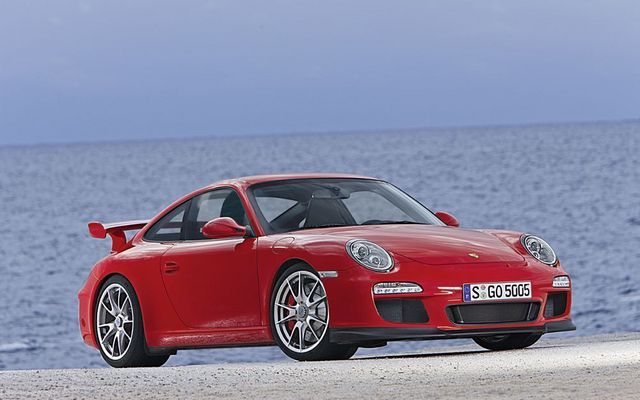The 2010 Porsche 911 GT3: The real 911…
Hohenstein-Ödenwaldstetten, Germany – Over the years, the Porsche 911 has evolved to the point that today it comes in a wide range of models, including the one that expresses the spirit and philosophy of this mythic car more than the rest: the GT3. The engineers in Porsche’s racing department, who are practically obsessive about weight reduction, aerodynamics, maximizing handling and power, have always been responsible for developing this lighter and sportier 911. This is a very exclusive car - Porsche made only 5,300 of the previous GT3, and a mere 52 of the 2010 GT3s have been allocated to Canadian dealerships, which are offering it at a base price of $138,100.
GT3 owners often say that their cars are addictive, and after having the chance to drive the previous GT3 model seven times on the Circuit Mont-Tremblant last summer as the head instructor of the Trioomph Challenge, it’s easy to see why, as only the Ferrari F430 surpassed the GT3 on this circuit. For the launch of the new model, Porsche didn’t reserve a track, preferring instead that journalists drive the car on public roads. However, I was able to push the limits the new GT3 somewhat on little used back roads and a fairly long stretch with no speed limit on a section of the Autobahn.
The new GT3’s ride is not unlike the previous model.
It is quite simply a race car with a license plate. It’s extremely fast and has surgical precision, responding immediately to the slightest touch and instantly connecting the driver and the road. Behind the wheel, it feels like a race car. The chassis is so rigid that it seems as though it has been carved from one single piece, the stick shift is ultra-precise, which means that you feel each gear engage, and the sound of the engine is so captivating that you’ll push each gear to the 8,500 rpm limit before shifting. It is intoxicating, to say the least. On the technical side, the most important of the numerous modifications made to the new GT3 compared to the previous model, were to the engine, the suspensions and brakes, the electronic driving aides and the aerodynamics. The engine capacity of this six-cylinder boxer has gone from 3.6 to 3.8 litres, increasing the horsepower by 20 for a total of 435 at 7,600 rpm and the torque from 289 to 317 lbs-ft at 6,250 rpm.
The direct fuel injection and the PDK twin-clutch gearbox that were recently developed for the 911 Carrera and the Boxster S are conspicuous by their absence in the GT3. Porsche felt that the direct fuel injection wasn’t necessary for the GT3 since the half-litre per 100 km improvement in fuel consumption wasn’t a concern for the typical client. As for the PDK gearbox, the extra 30 kilos are just too much considering the goal was to be as light-weight as possible.
So is the new GT3 faster than the previous model? The answer is yes, but not by much. It goes from 0 to 100 km/h in 4.1 seconds, two tenths of a second faster, and the top speed is 312 km/h. Although these improvements don’t seem impressive, don’t forget that the bar was already set very high... The new engine featuring 114.5 horses per litre of engine of engine capacity, a limit of 8,500 rpm (100 better than before despite the increased engine capacity) and seven oil pumps to deal with the extremely powerful lateral acceleration in turns on the track, represents a veritable stroke of genius for Porsche’s engineers. The new GT3 also has an improved version of the PSM electronic stability control that is so well-calibrated that this system only intervenes when it’s absolutely necessary and does so ever so delicately, which means you can also exploit the performance potential to the fullest. And if you feel the urge to do doughnuts, you can deactivate either the traction control system alone, or both it and the electronic stability control using buttons located at the base of the central console.
There are two interesting new options, but there wasn’t enough time to make them available on the first GT3s off the assembly line. The first is a system that helps increase the front end’s ground clearance by 30 millimetres or 1.2 inches to clear certain garage entrances without scratching the Lamborghini Gallardo-style spoiler lip. The second is what makes the 0-100 km/h time better: dynamic hydraulic engine mounts that automatically make the engine more rigid by passing an electric current through a fluid loaded with magnetic particles to completely eliminate engine movement in the chassis when you call upon the engine at wide open throttle on the track or for flat out accelerations. Follow these steps if you want a blazing fast time with a GT3 equipped with this option: select sport mode, deactivate the traction control and the electronic stability control, put the car in first gear and bring the engine speed to and maintain precisely 4,500 rpm. The next step is the most crucial: releasing the clutch is where everything can go to pot.
If you don’t release the clutch fast enough, it’s the clutch disc itself that is going to suffer. Rather, you have to move your left foot laterally with brutal firmness so that the pedal comes back up immediately and completely, engaging the clutch immediately and completely in one shot. The rear tires will take the impact and will leave skid marks on the road.
As for style, the new GT3 features enlarged front and rear air vent openings and a new fixed rear wing with wing uprights branded with the number “3.8” – a reference to the upgrated engine capacity of the new model. The improved aerodynamics have helped double the high speed downforce compared to the previous model and accelerated air flow to the engine in addition to cooling off the engine and the brakes, which are simultaneously larger and lighter than those that equipped the previous model.
The GT3 is so performance-oriented that it’s just as much at ease on public roads as on race tracks where 70 percent of this car’s clientele tend to go to have a blast on occasion. This also means that the GT3 isn’t ideally suited for everyday driving. The suspensions are so firm that driving on rough roads can quickly become uncomfortable, the sound of the engine can become overwhelming over time and the GT3 has no rear seats. It’s the ideal car for solo driving if you like this authentic sports car’s incisive reactions, but you have to realize that the passenger will not always appreciate the GT3’s more radical side on a long trip. As for the budget, you should plan to replace the tires every 8,000 or 9,000 kilometres, and the Pirelli or Michelin 235/35 ZR19 front tires and 305/30 ZR19 back tires that this car is fitted with are not cheap…
The new GT3 is a perfect example of Porsche’s philosophy of making constant improvements to its cars. This car isn’t a giant step forward compared to the previous model. Rather, it’s an evolution toward better performances that make it the best 911 to date.












